brake TOYOTA PROACE VERSO 2020 Owners Manual
[x] Cancel search | Manufacturer: TOYOTA, Model Year: 2020, Model line: PROACE VERSO, Model: TOYOTA PROACE VERSO 2020Pages: 418, PDF Size: 39.32 MB
Page 3 of 418

.
.
Driving recommendations 192Starting-switching off the engine, manual key, remote control 195Starting and switching off the engine, 198"Smart Entry & Start System" 198Parking brake 201Hill start assist control (HAC) 2025 -speed manual gearbox 2036 -speed manual gearbox 203Gear shift indicator 204Automatic gearbox 205Electronic gearbox 210Stop & Start 214Head-up display 218Adjustable Speed Limiter (ASL) 220Road Sign Assist 221Speed limiter 225Cruise control 228Adaptive cruise control 232Forward collision warning and Autonomous emergency braking system with Pedestrian Detection 239Lane Departure Alert 245Driver Attention Alert 247Blind spot monitoring system 249Parking sensors 252Reversing camera, interior mirror 254180° rear vision 255Tyre Pressure Warning System (TPWS) 258
Fuel tank 261Diesel misfuel prevention 262Snow chains 264Towing a trailer 265Energy economy mode 266Accessories 267Roof bars / Roof rack 268Changing a wiper blade 269B o nn et 271Diesel engine 272Checking levels 273Checks 276AdBlue® and SCR system (Diesel) 278
Warning triangle (stowing) 282Tool box 282Temporary puncture repair kit 285Changing a wheel 291Changing a bulb 298Changing a fuse 31112 V battery 316To w i n g 3 2 0Running out of fuel (Diesel) 322
Dimensions 323Engines 324Weights 324Identification markings 327
DrivingPractical information
In the event of a breakdown
Technical data
Emergency or assistance 328Toyota Pro Touch with navigation system 331To y o t a P r o To u c h 367Toyota Radio Bluetooth 387
Audio and telematics
Alphabetical index
Contents
Page 5 of 418
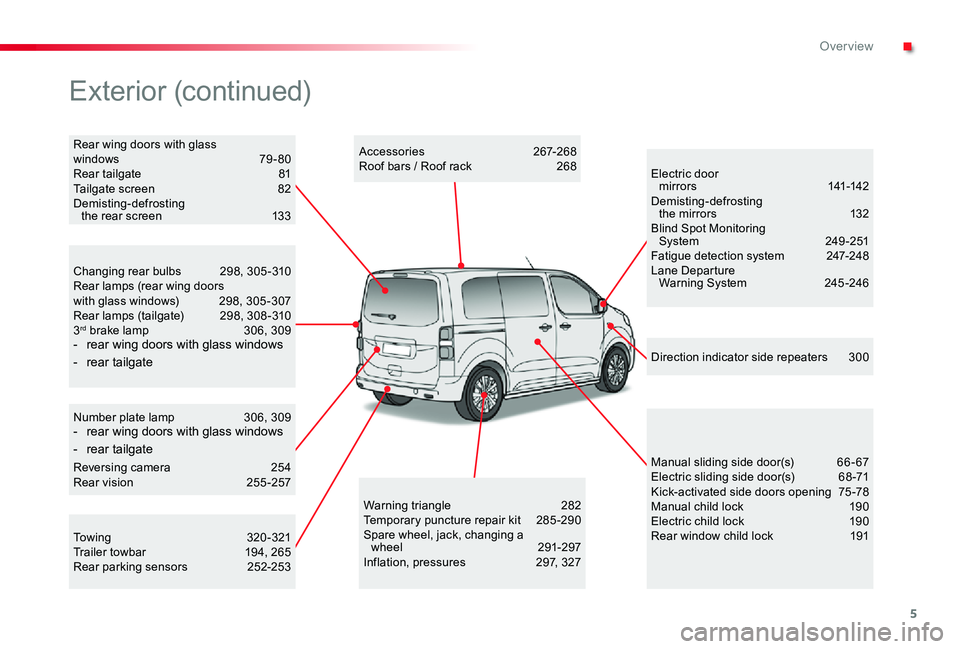
5
Number plate lamp 306, 309- rear wing doors with glass windows
- rear tailgate
Reversing camera 254Rear vision 255 -257
Changing rear bulbs 298, 305 -310Rear lamps (rear wing doorswith glass windows) 298, 305 -307Rear lamps (tailgate) 298, 308 -3103rd brake lamp 306, 309- rear wing doors with glass windows
- rear tailgate
Warning triangle 282Temporary puncture repair kit 285 -290Spare wheel, jack, changing a wheel 291-297Inflation, pressures 297, 327
Electric door mir ror s 141-142Demisting-defrosting the mirrors 132Blind Spot Monitoring System 249-251Fatigue detection system 247-248Lane Departure Warning System 245 -246
Direction indicator side repeaters 300
Manual sliding side door(s) 66 - 67Electric sliding side door(s) 68 -71Kick-activated side doors opening 75 -78Manual child lock 190Electric child lock 190Rear window child lock 191
Accessories 267-268Roof bars / Roof rack 268
Towing 320-321Trailer towbar 194, 265Rear parking sensors 252-253
Rear wing doors with glasswindows 79-80Rear tailgate 81Tailgate screen 82Demisting-defrosting the rear screen 133
Exterior (continued)
.
Over view
Page 6 of 418

6
Instruments and
controls
Courtesy lamps 140Interior mood lighting 153- courtesy lamp
- panoramic roof
Rear view mirror 143Reversing camera on interior mirror 254ERA-GLONASS emergency call system 158, 328 -329
12 V accessory socket 113USB port 113Deactivating the passenger front airbag 170, 176
5/6 -speed manual gearbox 203Gear efficiency indicator 204Automatic gearbox 205-209Electronic gearbox 210 -213Stop & Start 214-217Hill start assist control 202
Manual air conditioning 125-126Dual-zone air conditioning 127-130Rear heating, air conditioning 136Air recirculation 125, 130Front demist - defrost 131Rear screen demist - def rost 13 3
Parking brake 201
Opening the bonnet 271
Dashboard fuses 311-314
Touch screen (Toyota Pro Touch withnavigation system) 41, 331-366Touch screen (Toyota ProTouch) 41, 367-386
Toyota Radio Bluetooth 44, 387- 409Air vents 134
Setting the date and time 44
Over view
Page 9 of 418
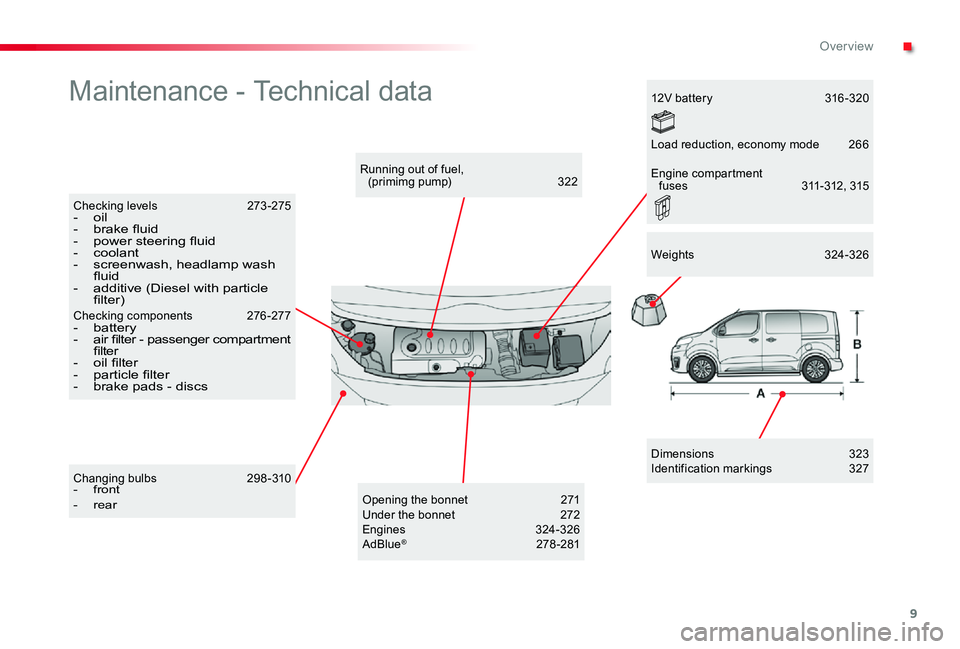
9
Maintenance - Technical data
Dimensions 323Identification markings 327
Running out of fuel, (primimg pump) 322
Checking levels 273 -275- oil- brake fluid- power steering fluid- coolant- screenwash, headlamp wash fluid- additive (Diesel with particle filter)
Checking components 276 -277- battery- air filter - passenger compartment filter- oil filter- particle filter- brake pads - discs
Changing bulbs 298-310- front- rear
12V battery 316 -320
Opening the bonnet 271Under the bonnet 272Engines 324-326AdBlue® 278 -281
Weights 324-326
Load reduction, economy mode 266
Engine compartment fuses 311- 312, 315
.
Over view
Page 11 of 418
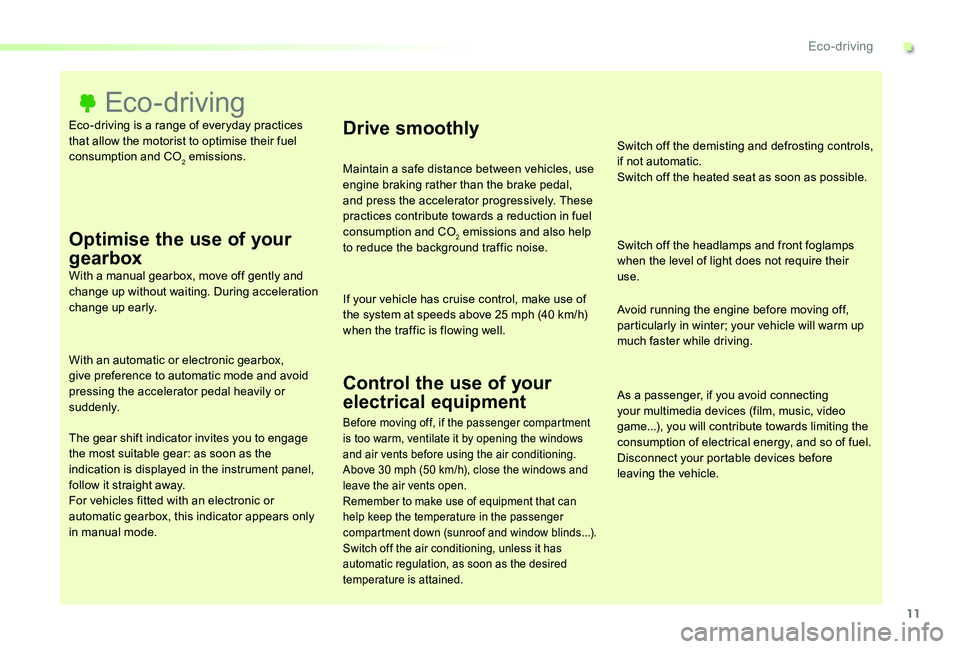
11
Eco-driving is a range of everyday practices that allow the motorist to optimise their fuel consumption and CO2 emissions.
Eco- driving
Optimise the use of your
gearboxWith a manual gearbox, move off gently and change up without waiting. During acceleration change up early.
With an automatic or electronic gearbox, give preference to automatic mode and avoid pressing the accelerator pedal heavily or suddenly.
The gear shift indicator invites you to engage
the most suitable gear: as soon as the indication is displayed in the instrument panel, follow it straight away.For vehicles fitted with an electronic or automatic gearbox, this indicator appears only in manual mode.
Drive smoothly
Maintain a safe distance between vehicles, use engine braking rather than the brake pedal, and press the accelerator progressively. These practices contribute towards a reduction in fuel consumption and CO2 emissions and also help to reduce the background traffic noise.
If your vehicle has cruise control, make use of the system at speeds above 25 mph (40 km/h) when the traffic is flowing well.
Control the use of your
electrical equipment
Switch off the demisting and defrosting controls, if not automatic.Switch off the heated seat as soon as possible.
Switch off the headlamps and front foglamps when the level of light does not require their use.
Avoid running the engine before moving off, particularly in winter; your vehicle will warm up much faster while driving.
As a passenger, if you avoid connecting your multimedia devices (film, music, video game...), you will contribute towards limiting the consumption of electrical energy, and so of fuel.Disconnect your portable devices before leaving the vehicle.
Before moving off, if the passenger compartment is too warm, ventilate it by opening the windows and air vents before using the air conditioning.Above 30 mph (50 km/h), close the windows and leave the air vents open.Remember to make use of equipment that can help keep the temperature in the passenger compartment down (sunroof and window blinds...).Switch off the air conditioning, unless it has automatic regulation, as soon as the desired temperature is attained.
.
Eco-driving
Page 16 of 418

16
Warning / indicator lampStateCauseAction / Observations
STOPfixed, associated with another warning lamp, accompanied by an audible signal and a message.
Illumination of this warning lamp is related to a serious fault detected with the engine, the braking system, the power steering, etc., or a major electrical fault.
You must stop as soon as it is safe to do so.Park, switch off the ignition and call an authorized Toyota dealer or repairer, or another duly qualified and equipped professional immediately.
Parking brakefixed.The parking brake is applied or not
properly released.
Release the parking brake to switch off the warning
lamp, keeping your foot on the brake pedal.Obser ve the safety recommendations.For more information on the Parking brake, refer to the corresponding section.
Brakingfixed.The brake fluid level has dropped significantly.You must stop as soon as it is safe to do so.Top-up with brake fluid listed by Toyota.If the problem persists, have the system checked by an authorized Toyota dealer or repairer, or another duly qualified and equipped professional immediately.
+
fixed, associated with the ABS warning lamp.
The electronic brake force distribution (EBFD) system has a fault.You must stop as soon as it is safe to do so.Have it checked by an authorized Toyota dealer or repairer, or another duly qualified and equipped professional immediately.
Instruments
Page 19 of 418

19
Warning / indicator lampStateCauseAction / Observations
+
Engine auto-diagnosis system
fixed, associated with the STOP warning lamp.
A major engine fault has been detected.You must stop as soon as it is safe to do so.Park, switch off the ignition and contact an authorized Toyota dealer or repairer, or another duly qualified and equipped professional immediately.
Diesel engine pre-heatingfixed.The ignition switch is at the 2nd position (igntion on).OrThe "START/STOP" button has been pressed.
Wait until the warning lamp goes off before starting.Once it goes off, starting is immediate, on condition that:- the clutch pedal is pressed fully down with a manual gearbox,- pressure is maintained on the brake pedal with an automatic or electronic gearbox.The period of illumination of the warning lamp is determined by the ambient conditions (up to about thirty seconds in extreme
conditions).If the engine does not start, switch the ignition off and then on, wait until the warning lamp goes off again, then start the engine.
Engine auto-diagnosis system
fixed.The emission control system has a fault.The warning lamp should go off when the engine is started.If it does not go off, contact an authorized Toyota dealer or repairer, or another duly qualified and equipped professional immediately.
flashing.The engine management system has a fault.Risk of destruction of the catalytic converter.Have it checked by an authorized Toyota dealer or repairer, or another duly qualified and equipped professional immediately.
+
fixed, associated with the SERVICE warning lamp.
A minor engine fault has been detected.Have it checked by an authorized Toyota dealer or repairer, or another duly qualified and equipped professional immediately.
1
Instruments
Page 20 of 418
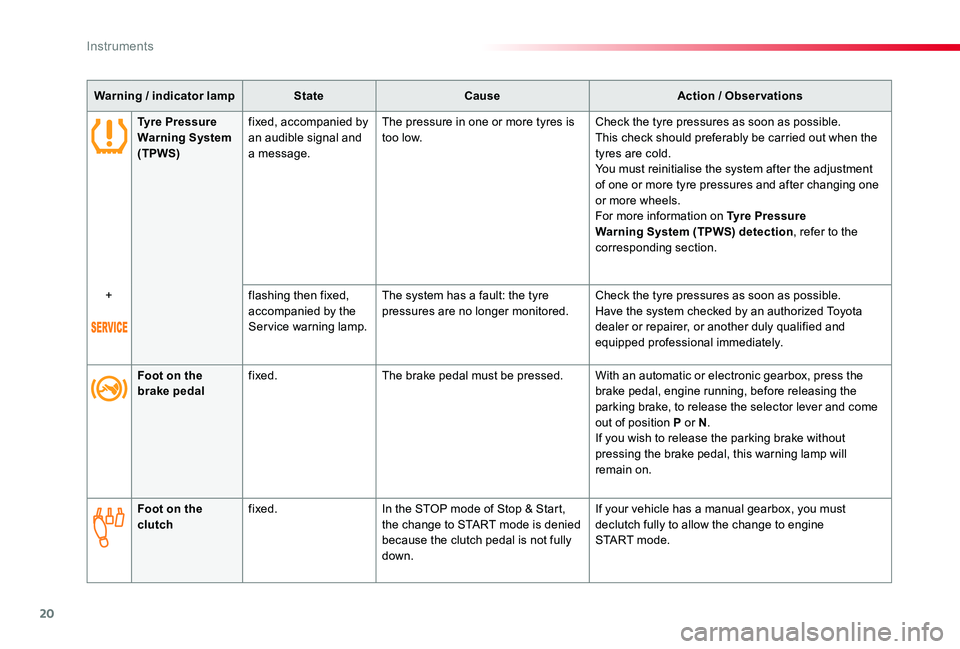
20
Warning / indicator lampStateCauseAction / Observations
Foot on the brake pedalfixed.The brake pedal must be pressed.With an automatic or electronic gearbox, press the brake pedal, engine running, before releasing the parking brake, to release the selector lever and come out of position P or N.If you wish to release the parking brake without pressing the brake pedal, this warning lamp will remain on.
Foot on the clutchfixed.In the STOP mode of Stop & Start, the change to START mode is denied because the clutch pedal is not fully down.
If your vehicle has a manual gearbox, you must declutch fully to allow the change to engine S TA R T m o d e .
Tyre Pressure Warning System (TPWS)
fixed, accompanied by an audible signal and a message.
The pressure in one or more tyres is too low.Check the tyre pressures as soon as possible.This check should preferably be carried out when the tyres are cold.You must reinitialise the system after the adjustment of one or more tyre pressures and after changing one or more wheels.For more information on Tyre Pressure Warning System (TPWS) detection, refer to the corresponding section.
+flashing then fixed, accompanied by the Ser vice warning lamp.
The system has a fault: the tyre pressures are no longer monitored.Check the tyre pressures as soon as possible.Have the system checked by an authorized Toyota dealer or repairer, or another duly qualified and equipped professional immediately.
Instruments
Page 21 of 418
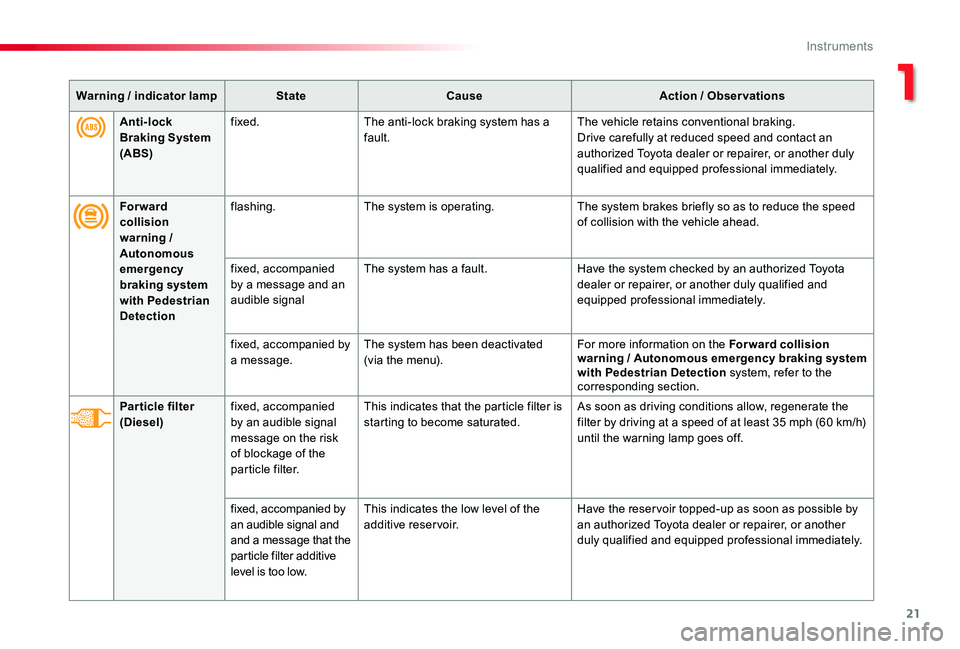
21
Warning / indicator lampStateCauseAction / Observations
For ward collision warning /
Autonomous emergency braking system with Pedestrian Detection
flashing.The system is operating.The system brakes briefly so as to reduce the speed of collision with the vehicle ahead.
fixed, accompanied by a message and an audible signal
The system has a fault.Have the system checked by an authorized Toyota dealer or repairer, or another duly qualified and equipped professional immediately.
fixed, accompanied by a message.The system has been deactivated (via the menu).For more information on the Forward collision warning / Autonomous emergency braking system with Pedestrian Detection system, refer to the corresponding section.
Par ticle filter (Diesel)fixed, accompanied by an audible signal message on the risk of blockage of the particle filter.
This indicates that the particle filter is starting to become saturated.As soon as driving conditions allow, regenerate the filter by driving at a speed of at least 35 mph (60 km/h) until the warning lamp goes off.
fixed, accompanied by an audible signal and and a message that the particle filter additive level is too low.
This indicates the low level of the additive reservoir.Have the reser voir topped-up as soon as possible by an authorized Toyota dealer or repairer, or another duly qualified and equipped professional immediately.
Anti-lock Braking System (ABS)
fixed.The anti-lock braking system has a fault.The vehicle retains conventional braking.Drive carefully at reduced speed and contact an authorized Toyota dealer or repairer, or another duly qualified and equipped professional immediately.
1
Instruments
Page 159 of 418
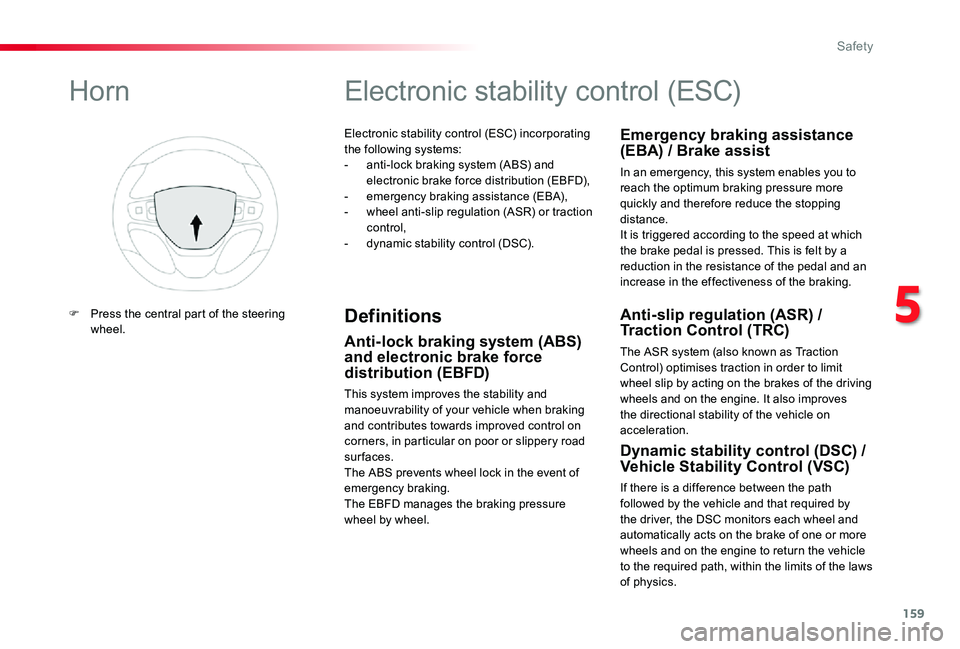
159
ER A - GLONASS
emergency call system*Electronic stability control (ESC) incorporating the following systems:- anti-lock braking system (ABS) and electronic brake force distribution (EBFD),- emergency braking assistance (EBA),- wheel anti-slip regulation (ASR) or traction control,- dynamic stability control (DSC).
Electronic stability control (ESC)
Definitions
Anti-lock braking system (ABS) and electronic brake force distribution (EBFD)
This system improves the stability and manoeuvrability of your vehicle when braking and contributes towards improved control on corners, in particular on poor or slippery road surfaces.The ABS prevents wheel lock in the event of emergency braking.The EBFD manages the braking pressure wheel by wheel.
Emergency braking assistance (EBA) / Brake assist
In an emergency, this system enables you to reach the optimum braking pressure more quickly and therefore reduce the stopping distance.It is triggered according to the speed at which the brake pedal is pressed. This is felt by a reduction in the resistance of the pedal and an increase in the effectiveness of the braking.
Anti-slip regulation (ASR) / Traction Control (TRC)
The ASR system (also known as Traction Control) optimises traction in order to limit wheel slip by acting on the brakes of the driving wheels and on the engine. It also improves the directional stability of the vehicle on acceleration.
Dynamic stability control (DSC) / Vehicle Stability Control (VSC)
If there is a difference between the path followed by the vehicle and that required by the driver, the DSC monitors each wheel and automatically acts on the brake of one or more
wheels and on the engine to return the vehicle to the required path, within the limits of the laws of physics.
Horn
F Press the central part of the steering wheel.
5
Safety